|
GRAMERCY GRAPHIC,
January 1959
The
Bank for Savings Exhibits
Ferguson Mechanical Banks
OVER
a period of eight years, William F. Ferguson, formerly vice president of
The Bank for Savings, 280 Fourth Avenue, pursued a fascinating hobby-the
collection of mechanical coin banks. When he
retired in 1948, after 41-1/2 years with the
bank, he gave it his entire collection. A number
of the items are now on view in the main banking room and will remain
until the end of February.
The
mechanical ingenuity shown in many of these banks is amazing;
and it is easy to see how they must have
stimulated saving. Who wouldn't like to give an eagle a penny, and have it
flip it from its mouth to eaglets in the nest? That's what happens with
one of the banks in his display, and a similar
one is pictured at the bottom of this page in a reproduction of the card
originally used to advertise it. Other novelties in the exhibit are a
mother hen, from under whose wings come chicks when you drop a
penny in the slot; a monkey, hat in one hand, paddle in the other from
which he flips a penny into the organ. Or there's a bulldog who flips a
penny from his nose into his mouth, his interior being the bank; or the
Indian who shoots a penny from a gun into a bear .
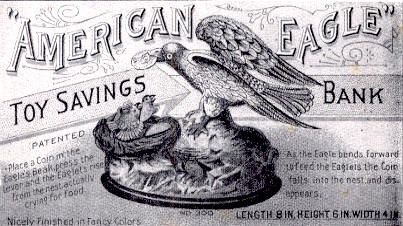
This was at one time one of the most
popular mechanical banks. This illustration is from a
colored card which was used as an advertisement. Operation depends
upon the pressing of a lever. As the eagle dips down to "feed" the
eaglets, she spreads her wings at the same time,
and a little squeak comes from a bellows inside as she opens he
mouth and the coin drops into the bank.
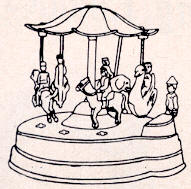
In the case of this "Merry-Go-Round"
bank, the coin is placed
in the tray by a little man (right) ; turn the crank and the coin drops
into the bank as the animals go round, while the little man urges
them on with a whip and the bells ring.
Mr. Ferguson, who now resides at 89 Bon Air Drive, New Rochelle, N.
Y., does not collect banks any more, and his
other collections of milk glass, plates, beehive items
(the beehive is the symbol of The Bank for Savings) are as large as
he wants them to be. His chief occupation now —
and has been for the past decade — is collecting
pictures and writing the history of the village of Worcester, N.
Y., where he was born. He has completed eight volumes of this
painstaking work, and has still more to do. When the history is completed,
it will be a complete pictorial and written record of every house and
every family in the village. Eventually it will be turned over to
the New York State Historical.
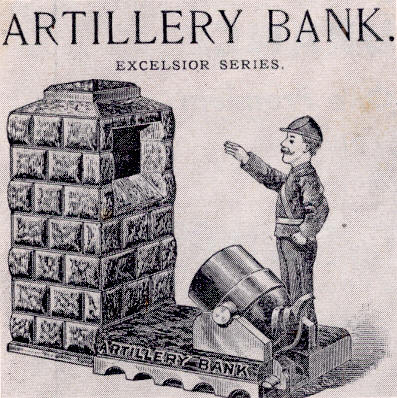
This bank is eight inches long, and was
finished in bronze or "fancy colors."
The coin is placed in the cannon. When the hammer is pushed back
and the thumb piece pressed upon, the coin is fired into the fort or
tower.
As to the mechanical bank collection,
which he still regards with fondness, he has written the following
:
I COLLECTED
MECHANICAL BANKS
By William F. Ferguson
I began collecting banks one day in 1934 when, just by chance, I
wandered with some other people into a little red barn antique shop.
Looking around at "the old things" I spied a bank and was reminded of an
article I had recently read of a noted
collector's banks. The specimen before me had been particularly described
in the article, therefore it must be a rare one.
I
asked the price — $5 —"what
a terrible price for an old second hand toy!" I
thought. Turned it down, of course, but while my friends were still busy,
I kept walking back to examine it, getting more interested all the time.
Fearing I'd never have such a chance at a bargain, I bought it. In due
time I found I had paid top price. This wasn't a rare bank
— just one of the most interesting ones. It was a "Tammany Bank,"
patented in 1873 and '75, representing Boss Tweed —
a little man sitting in a chair with his hand out for money. The
weight of a coin made his arm drop down, the coin dropped into his breast
pocket and he nodded his head.
Made Many
Friends
This was the beginning of my
eight years' intensive collecting
of mechanical banks. Combined with my love
for motoring trips, this new collecting interest took me out in the
country from Maine to Virginia. It started many lasting acquaintanceships
with many fine people — antique dealers and
especially several collectors, a lasting friendship. Of course,
being a Savings Banker, must have added to my interest
in banks.
Back
in the 1930's — the depression
days — people needed money and were willing to let dealers search
their attics for "the old stuff that might bring in some cash." Dealers
were anxious for a quick turnover and since there were perhaps only a
dozen or two of bank collectors, we had good pickings. No one knows just
how many collectors there are now, but it's over a thousand, I'm sure.
The
question-which is the most valuable bank? — is
hard to answer. Of the two hundred and fifty different mechanicals known
there are several of which only one has been found. These are scattered
among different owners and perhaps each think their own is the most
valuable, but I doubt if any
one of them would bring the price paid a few years back for the
"Harlequin, Clown and Columbine" (1877) of which there are at least six in
existence — the most coveted bank of them all.
It is a wind-up bank, with the three traditional pantomime figures
standing on the base. When a coin is inserted and lever pressed, the
Columbine is twirled around by the Clown.
The
price a bank sells for depends mainly on the number of that kind which
shows up, varied a bit according to desirability, that is, as to whether
they are more or less interesting in mechanical action. Late in the 1870's
some makers of mechanical toys and "still" banks in the shape of animals,
safes and the like, conceived the idea of putting out a mechanical bank.
(To be continued)
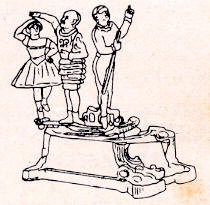
Here the Clown,
Harlequin and Columbine put on a
combination
stunt. Columbine pirouettes around the
clown.
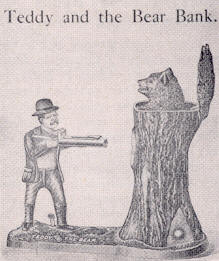
Popularly known as "Teddy and the
Bear," this bank demonstrates the rather
unlikely (in real life) happening of
Teddy firing into a stumpo (top closed),
whereupon the bear pops up.
Height of this was nine inches.
Subscribe to GRAMERCY GRAPHIC — 1 yr. $2,
2 yrs. $3
|





